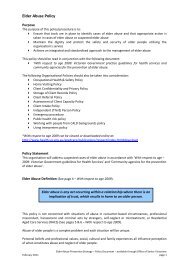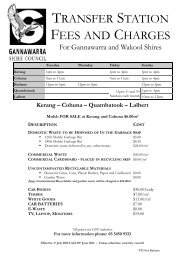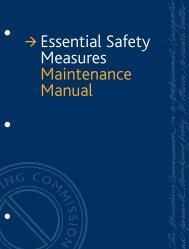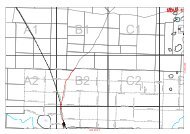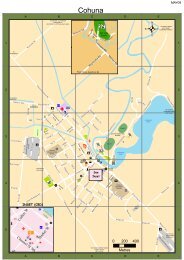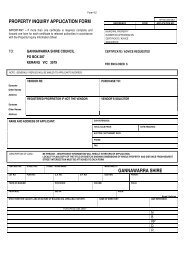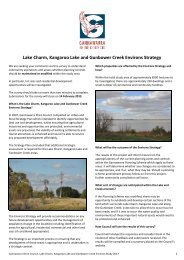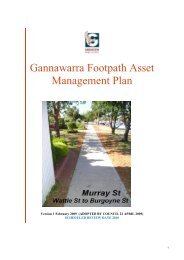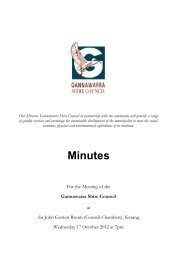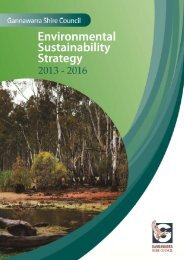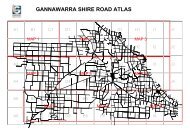Gannawarra Shire Heritage Study Stage One Volume One Thematic ...
Gannawarra Shire Heritage Study Stage One Volume One Thematic ...
Gannawarra Shire Heritage Study Stage One Volume One Thematic ...
Create successful ePaper yourself
Turn your PDF publications into a flip-book with our unique Google optimized e-Paper software.
Gold was discovered in Victoria in 1851, and by 1858, 150,000 people were at work on the goldfields in<br />
central Victoria. 28 With diminishing returns of alluvial gold on the fields of central Victoria, diggers<br />
demanded that land be freed from the hold of the squatter. ‘Every man a vote, a rifle, and farm’ was the cry of<br />
a demonstration outside parliament house in Melbourne in 1860. The subsequent Land Acts of the 1860s<br />
promoted the ideal of the creation of a new rural society of an ‘industrious yeomanry’ of freeholders.<br />
Under Duffy’s Land Act of 1862, it was proposed to open for selection an area of ten million acres of<br />
the most valuable agricultural land in Victoria for nine-year leases. The Grant Land Act of 1865 focused on<br />
controlled settlement in designated Agricultural Areas. Despite the fact that the best land in Victoria had been<br />
licensed by this time, the maximum holding-size was reduced to 320 acres. Each Act brought with it<br />
conditions that made it more difficult for squatting interests to select land. However through manipulating the<br />
legislation of the Acts, by 1869 squatters had in actuality consolidated their holdings.<br />
As exemplified by the actions of <strong>Gannawarra</strong> run licensee C. B. Fisher, although the 1869 Land Act<br />
was designed specifically to break the hold of the pastoralists who continued to monopolize the best lands,<br />
dummying continued. 29 Under the Act all unalienated land in the whole Colony was opened for selection of up<br />
to 320 acres. Land could only be selected once and squatters were able to purchase 640 acres around their<br />
homesteads (a pre-emptive right). Licences (Section 19s) were taken up for three years at 2s. per acre annual<br />
rental. Conditions under which licences were taken up under the 1869 Act were aimed at ‘improving’ the<br />
land. The selector was required to live on the selection for at least two and a half years, and within three years<br />
build a house to fulfil residency conditions, fence the selection, cultivate at least ten per cent of the land, and<br />
effect other improvements such as clearing vegetation, constructing water storages, and erecting outbuildings.<br />
If improvements at a rate of £1 per acre were made within this time, the selector could either purchase the<br />
land by paying the balance of 14/- per acre, or obtain a seven year lease (Section 20) paid at an annual rent of<br />
2/- per acre and credited as part payment of the fee-simple. Under this Act one million acres were selected in<br />
1872, and in the four years from 1873 to 1876 over five million. By the end of 1878, nearly eleven million<br />
acres had been taken up, mostly in the mountainous country of Gippsland and on the plains of the north. 30<br />
This Act and the high rainfall years of the early 1870s brought selectors in numbers to the country of<br />
the present day <strong>Gannawarra</strong> <strong>Shire</strong>. Some settlers selected land in family groups and farmed the land as one<br />
holding in an effort to make farming more viable. Small acreages of wheat or oats were cultivated, a vegetable<br />
garden planted, and pigs and poultry raised along with a few head of sheep and cattle. Cows were kept for the<br />
sale of butter and cream. By the dry year of 1876 however, farmers in the area were experiencing difficulties.<br />
Continuous cropping, the invasion of rabbits from the Mallee, low prices, and the production for international<br />
28<br />
Graeme Davison, John Hirst, and Stuart Macintyre, eds., The Oxford Companion to Australian History (Melbourne:<br />
Oxford University Press, 1998), 283.<br />
29<br />
‘Dummies’ were nominal selectors acting on behalf of someone else to apply for land or in fulfilling the residency<br />
conditions. After paying off their leases under the Land Act, they transferred title to the squatter.<br />
30<br />
John Andrews, “The Emergence of the Wheat Belt in Southeastern Australia in 1930” in John Andrews, ed., Frontiers<br />
and Men: A <strong>Volume</strong> in Memory of Griffith Taylor (1880-1963) (Melbourne: F. W. Cheshire, 1966).<br />
<strong>Gannawarra</strong> <strong>Shire</strong> <strong>Heritage</strong> <strong>Study</strong> <strong>Stage</strong> <strong>One</strong> <strong>Volume</strong> <strong>One</strong> <strong>Thematic</strong> Environmental History<br />
Robyn Ballinger (History in the Making) December 2008<br />
14



